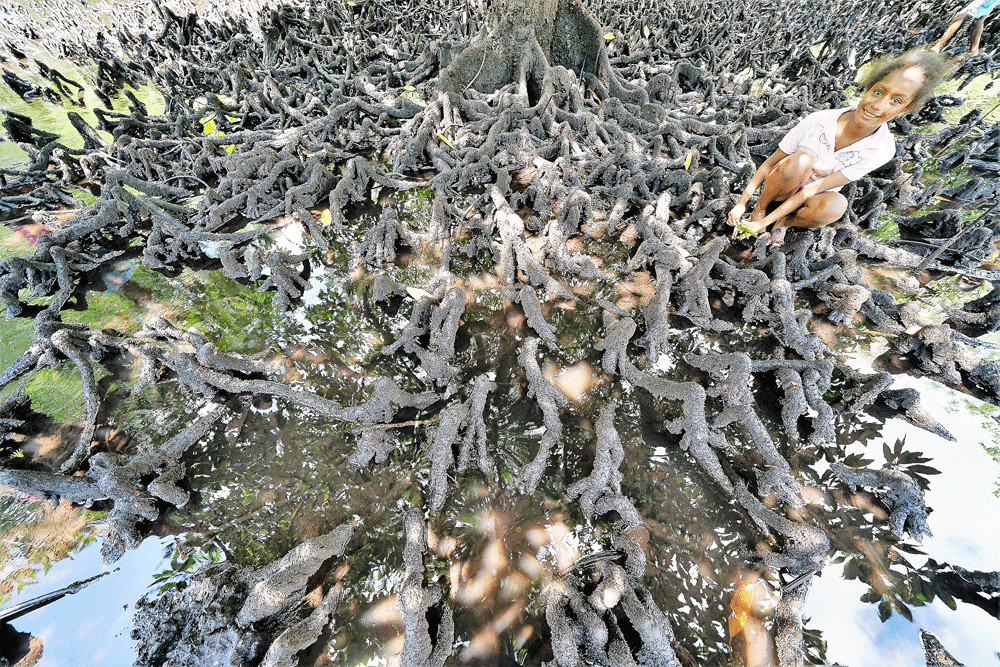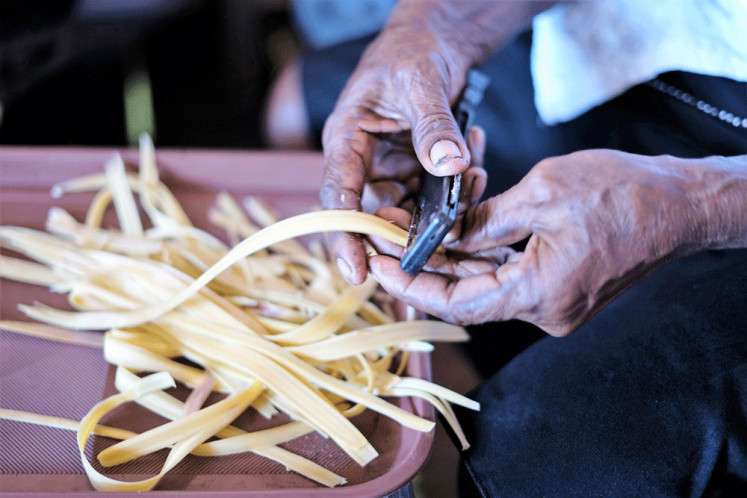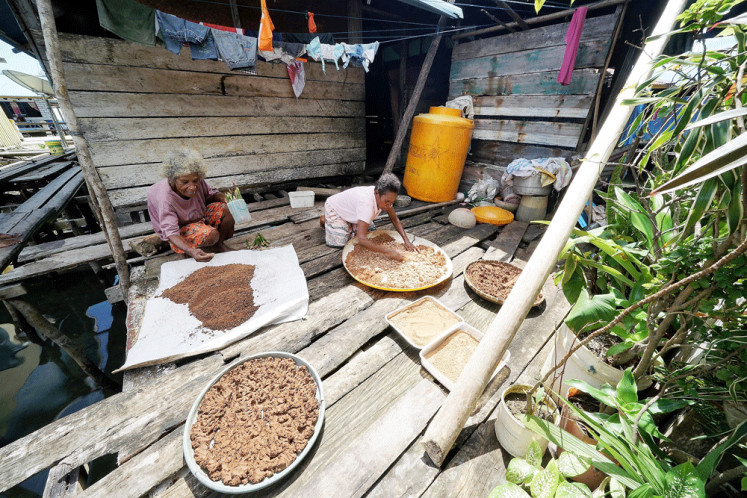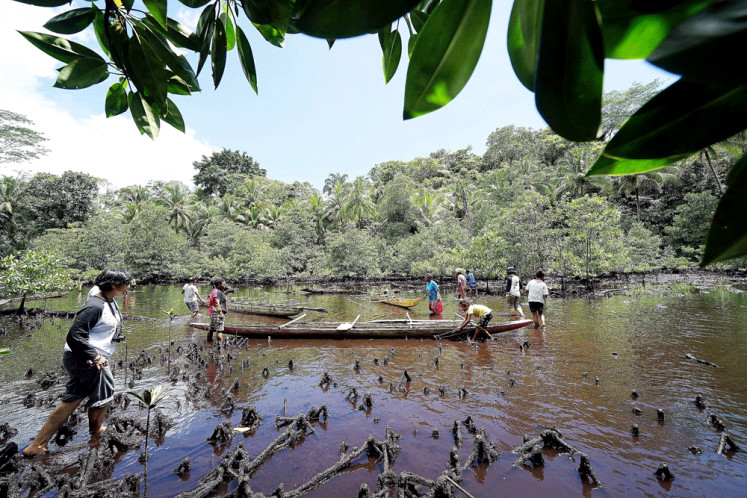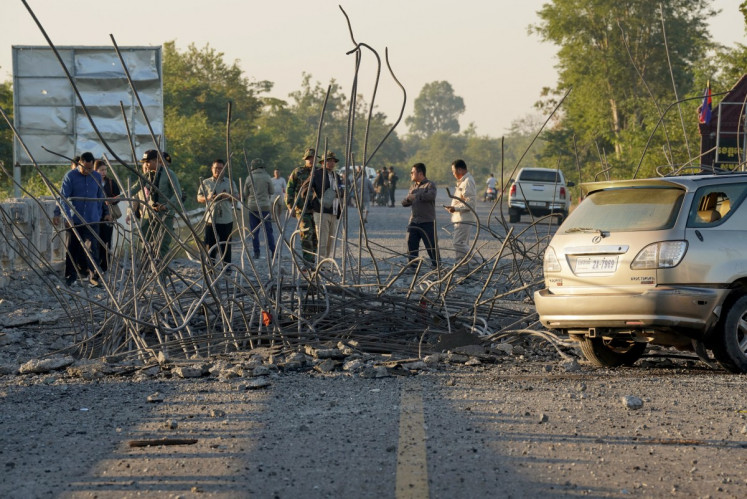Popular Reads
Top Results
Can't find what you're looking for?
View all search resultsPopular Reads
Top Results
Can't find what you're looking for?
View all search resultsSowek's sustainable mangrove management
The people living in Sowek, Papua, loyally preserve the region’s mangrove heritage.
Change text size
Gift Premium Articles
to Anyone
S
owek, a remote region in the Aruri Islands of Papua’s Supiori regency, is a mangrove zone that for generations has been supplying food to its people, who conserve the trees as part of their commitment to sustaining natural resources.
The sea was calm when 13-year-old Kace Wambraw sailed in Sowek’s waters.
Kace was heading for Kasoni, a secluded bay located around 90 minutes by boat from his home. He was singing along with three friends as the boat cruised past coral reefs before entering the bay.
A group of women were also sailing in the same direction, joking around throughout the journey. Mangrove trees provided shade throughout the bay area, although boaters have to take care to avoid getting tangled up in the protruding roots lush the green Kasoni.
“We’ve gotten used to being here,” said Kace as he and his friends left the boat to seek mangrove fruits.
The mangroves at Kasoni bay belong to the large species of lindur and their fruits are known as aibon.
Within minutes, Kace had gathered a heap of aibon. Meanwhile, the group of women also searched for aibon, turning the normally quiet Kasoni into a busy place.
Work in progress: A Sowek woman peels the aibon fruits to be processed. (The Jakarta Post/Syafrizaldi)Aibon fruits are elongated with reddish green blunt tips, 25 centimeters in length on average, with yellow crowns near their bases.
Young and green aibon fruits stick firmly to the trees, with their tips facing the muddy ground. After collecting fallen fruits, Kace began to search for ripe aibon from the trees with a wooden pole, helped by the women. The fruits dropped to the ground and children scrambled to gather them.
Meanwhile, the women were also picking fruits already bearing shoots for being overdue for harvest.
“Fruits with shoots are gathered for planting,” the oldest woman in the group, 63-year old Selvi Sawen, said.
Selvi, who is also Kace’s grandmother, guided Kace to plant the fruits in the vacant places around Kasoni.
“We aren’t just collecting fruits but we also grow mangroves for the generation following Kace,” Selvi said.
Other than the Kasoni bay, the Sowek community also search for aibon in the Odori bay. The two bays, with an area of almost 200 hectares, indeed make the mangrove forests a good place to harvest fruits.
The Sowek people love the taste of the aibon fruits and they usually make them into cakes. For a long time, the Sowek community has consumed aibonas a staple food.
Natural light: Sowek women prepare the processed aibon flour to dry under the sunlight. (The Jakarta Post/Syafrizaldi)“My granny used to eat aibon too. We aren’t like most Papuans, who eat sago. Sago palms are rarely found here,” Selvi said.
In the old days, the Sowek community also used aibon as a trade commodity.
Selvi, who is also the Debora Group chairperson of the Elim Sowek Christian Gospel Church, said in the past, the Sowek people used aibon as a mean of barter. Border crossers from Korido, Biak, Manokwari and their surroundings brought household goods to be exchanged for aibon.
According to Selvi, aibon has to be immersed in sea water for one night to soften it.
“After the immersion, the fruits are boiled once or twice. Ripe fruits are boiled once and young ones twice,” she explained.
Boiled aibon turns pale yellow and is ready for processing.
Some women started peeling the fruits into long thin sheets, which began to brown through oxidation. These sheets were then dried in the sun for further pounding. The flour resulting from the pounding was again dried to reduce its water content.
Light brown aibon flour is used by Sowek people as a substitute for wheat flour to make cakes. This flour can also be directly consumed by mixing it with brown sugar and coconut shreds.
Gather around: The Sowek people search for aibon fruits in the Kasoni bay, a staple of their diet. (The Jakarta Post/Syafrizaldi)World Wide Fund for Nature Indonesia communication director Elis Nurhayati said what the Sowek community had done in preserving their mangroves should be appreciated.
“Local people have managed the mangrove zone without diminishing its advantages. Its ecosystem remains conserved,” said Elis.
Mangroves constitute the critical habitat that supports a sound marine ecosystem as well as coral reefs and sea-grass beds.
“We get involved in integrating the mangrove zone into the Waters Conservation Zone management plan as well as the Coastal and Islet Region Zoning Plan,” Elis said.
The mangroves of Sowek have become a land and sea buffer zone along with its ecological function. Therefore, according to Elis, this region should receive priority in the management of sustainable natural resources.
[gal:4]
Elis continued that at the International Conference on Biodiversity, Ecotourism and Creative Economy in Manokwari on Oct. 10, 2018, the Manokwari Declaration was formulated, signed by the governors of Papua and West Papua, the Environment and Forestry Ministry and other development partners.
The declaration contains 14 points of understanding the management of sustainable natural resources in both provinces.
“The Sowek community can be committed to point number eight on the support for the discovery of product alternatives of high economic value and the active role of women in natural resources management, and point number 11 on the protection of essential conservation areas and mangrove zones,” Elis said.

